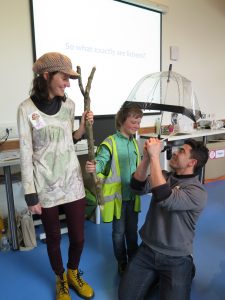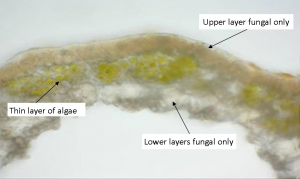
The ‘fungi’ is creating a protective ‘body’ for the algae (hi-viz & see-through umbrella) whilst holding on to the substrate (a stick in this case). The algae, sheltering under the fungi’s protection is making ‘food’ through photosynthesis (with a wooden spoon of course!)
Lichens are extraordinary organisms.
Easily overlooked, and often un-noticed by many people, lichens colonise trees and many other surfaces (walls, pavements, railings) in our urban areas.
Did you know that lichens are made up of not one but two or more different types of organisms living together in one body! This is known as a mutually beneficial relationship where each partner benefits from the other and results in their mutual survival in places they couldn’t live so well alone.
A lichen is made up of a fungi and an algae and/or cyanobacteria

Cross-section through a lichen thallus: the upper fawn-coloured surface is the protective ‘upper cortex’ (modified fungal cells), the green areas immediately below the upper surface are groups of green-algal cells, and the lower pale tissue are the fungal cells (‘hyphae’) in the ‘medulla’ (photo: Becky Yahr)
Why do they live together?
Fungi can’t make it’s own food so usually relies on getting it’s nutrients from rotting materials or partnering up with other organisms in order to get food. In a lichen, the fungi provides the protective ‘home’ or body of the lichen, protecting the algae from environmental changes such as extremes in temperature, moisture and UV. This means the algae can live in much drier or more exposed habitats than it could alone.
Algae are plants and can make their own food (carbon in the form of simple sugars) through the process of photosynthesis using energy from the sun. This ‘food’ is available to the fungi and means the fungi can live in places without relying on the surface it’s growing on (known as substrate) to provide nutrients.
Want to know more about lichens? Click here.
Part of the Edinburgh Living Landscape initiative & the TCV Natural Talent scheme
The Royal Botanic Garden Edinburgh has an active research programme to discover, protect and restore Scotland’s lichen diversity. Click here for further information.
